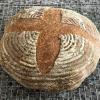
Infinity Bread (ft. Spelt)
This is a variation on the Infinity Bread from the recent Community Bake. The original used emmer as the third flour, and in a subsequent bake I posted a bread with einkorn. This time spelt became the third flour, and I am pleased with the result. Not as much oven spring as with the other two, but that seems typical of spelt. The flavor is great, and the crust has a nice crispiness.
For this bake I increased the amounts by 30% to achieve larger loaves, one of which was given to the crew at our local veterinarian office. We kept the other, and here are photos of the two loaves as well as the crumb from ours.
The loaves weighed 1172 grams and 1145 grams and each was in the oven for 44 minutes. Thanks again to PMCool for shepherding the Community Bake that began this adventure.


Comments
These loaves look terrific! Just the kind of results I'm always hoping to get. What hydration did you use for them?
TomP
Ah, hydration. That calculation seems to be done many different ways, so I will give you details and let you do the calculation based on your preferred methodology.
My starter is 100% hydration, and I used 52 grams of it.
Along with the starter, the levain contained 130 grams of bread flour, 130 grams of whole wheat flour, and 325 grams of water.
The final dough contained all of the levain along with 304 grams of bread flour, 303 grams of whole wheat flour, 433 grams of spelt flour, and 611 grams of water.
Some people include a soaker in the calculations, and some do not. I prefer the approach that the add-ins soak up all of the water, so that water is not counted in the hydration tally.
To my mind, the above result in a hydration of about 72.5%.
Here is how I get that figure. The flour in the levain (26 + 130 + 130) and the flour in the final dough (304 + 303 + 433) total 1326 grams. The water in the levain (26 + 325) and the water in the final dough (611) total 962 grams. Divide the water by the flour and get 962/1326 = .725 (about).
Regardless of the calculation, the components seem to go together well, and I would not adjust anything severely.
Happy baking (especially if you try this recipe).
Ted
You are really working the ancient wheat varieties in these Infinity Bread bakes. I am impressed with the results you have achieved in each of them. It looks like you nailed the fermentation in this spelt version.
Paul
The fermentation is always a guessing game, based in part on the temperature of the kitchen (70F for this mix) and dough just after initial mixing (72F). Those numbers portended a longer bulk fermentation, and this one lasted a bit over four hours. I use a Cambro tub and always lift the tub and look at the bottom of the mass of dough. If it is smooth, I wait. When bubbles have appeared in sufficient quantity, I dump the dough on the counter and divide for the pre-shape.
One key to each of my Infinity Bread bakes is the bread flour. That provides a lot of strength, which is essential if an ancient grain is involved and any kind of oven spring is desired. Another key is my starter, which I think is pretty robust. Your suggestion to use whole wheat flour as one-third of the flour in the bread has turned out to be exactly what I have been looking for. That is, a way to gain the flavor of whole wheat without having either a nearly entirely whole wheat dough or a minimal amount that is barely detectible.
Give one of these ancient grains a whirl sometime. Happy baking.
When I was thinking about what I wanted in the bread and trying to balance that with the bread having a good structure and texture, it was evident that there had to be a fair amount of wheat flour in the mix. The bread flour portion certainly helps provide gluten for structure, as does the whole wheat flour. The whole wheat flour also brings fiber from the bran plus nutrients in the germ (if you are able to mill your own, as I do).
The remaining flour can be just about anything the baker desires, including gluten-free flours, to achieve their flavor or texture or color or nutritional objectives. Ditto for any seeds, grains, nuts, fruits, or other inclusions. The dough has enough integrity and strength to carry the additional load without being stodgy.
It is very pleasing to see how you and others have found creative and delightful ways to “fill in the blanks” of this template. And yes, I do want to try some of the options that have been presented in this CB.
Paul
Those look wonderful Ted, better than what I see at great bakeries nearby.
Benny
Always appreciate your comments (and compliments). The bread flour and whole wheat provide a great foundation for adding another flour, and I really liked working with the emmer, einkorn, and spelt as the third flour in the combination.
Happy baking.
Ted